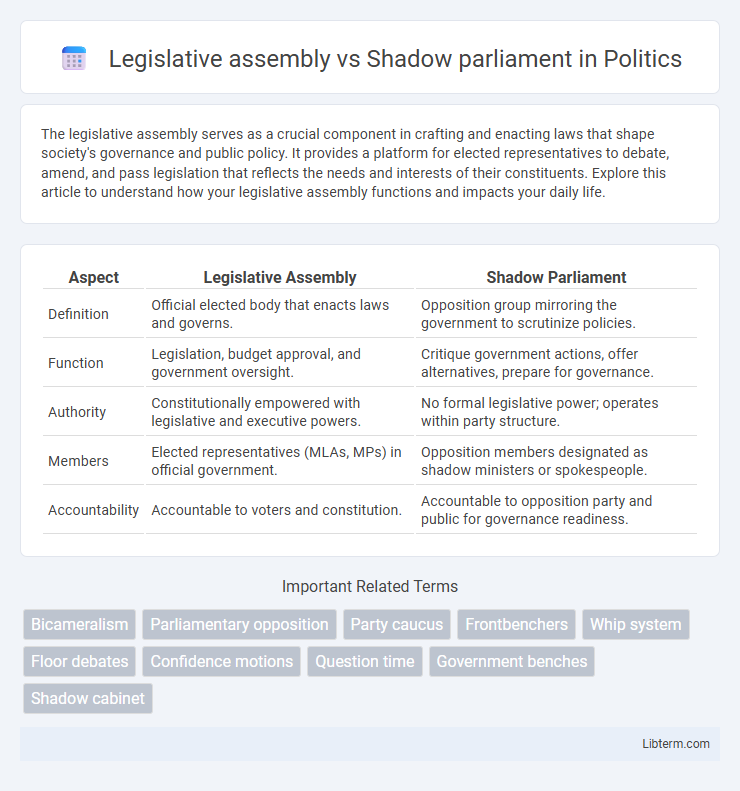The legislative assembly serves as a crucial component in crafting and enacting laws that shape society's governance and public policy. It provides a platform for elected representatives to debate, amend, and pass legislation that reflects the needs and interests of their constituents. Explore this article to understand how your legislative assembly functions and impacts your daily life.
Table of Comparison
| Aspect | Legislative Assembly | Shadow Parliament |
|---|---|---|
| Definition | Official elected body that enacts laws and governs. | Opposition group mirroring the government to scrutinize policies. |
| Function | Legislation, budget approval, and government oversight. | Critique government actions, offer alternatives, prepare for governance. |
| Authority | Constitutionally empowered with legislative and executive powers. | No formal legislative power; operates within party structure. |
| Members | Elected representatives (MLAs, MPs) in official government. | Opposition members designated as shadow ministers or spokespeople. |
| Accountability | Accountable to voters and constitution. | Accountable to opposition party and public for governance readiness. |
Introduction to Legislative Assemblies and Shadow Parliaments
Legislative assemblies are formal bodies of elected representatives responsible for creating, amending, and enacting laws within a government jurisdiction, typically organized at national or subnational levels. Shadow parliaments, often found in parliamentary systems, consist of opposition members who scrutinize government policies and propose alternatives without formal legislative power. Both institutions play crucial roles in democratic governance by ensuring accountability and fostering political debate.
Historical Origins and Evolution
The Legislative Assembly originated during the 18th century as a formal body for enacting laws within emerging parliamentary democracies, evolving from earlier council systems in British and colonial governance. The Shadow Parliament, emerging in the late 19th and early 20th centuries, developed as an institutionalized opposition mechanism in Westminster-style systems to hold the government accountable and propose alternative policies. Both entities reflect the evolution of democratic governance, with the Legislative Assembly representing direct legislative authority and the Shadow Parliament symbolizing structured political opposition.
Key Functions of a Legislative Assembly
A Legislative Assembly primarily enacts laws, approves budgets, and oversees government policies, representing the electorate's interests through elected members. It conducts debates, scrutinizes bills, and holds the executive accountable via question sessions and committees. In contrast, a Shadow Parliament comprises opposition members who monitor and critique the government's actions, offering alternative policies without legislative authority.
The Role of a Shadow Parliament
The Shadow Parliament plays a crucial role in holding the government accountable by scrutinizing policies and proposing alternatives through shadow ministers who mirror official cabinet positions. Unlike the Legislative Assembly, which enacts laws and governs directly, the Shadow Parliament operates from the opposition side, ensuring transparency and fostering democratic checks and balances. This system enhances political debate and prepares the opposition to assume power effectively if elected.
Structural Differences Between Legislative Assemblies and Shadow Parliaments
Legislative assemblies are official law-making bodies composed of elected representatives with the authority to enact laws, oversee government functions, and represent constituents within a political system. Shadow parliaments, often found in parliamentary democracies, consist of opposition members who mirror the structure and roles of the official assembly to scrutinize government policies and propose alternatives but lack formal legislative power. Structurally, legislative assemblies have formal legislative committees, voting rights, and procedural rules codified by law, whereas shadow parliaments operate informally without legislative authority, relying on parallel roles such as shadow ministers to challenge government positions.
Decision-Making Processes Compared
The Legislative Assembly operates as the primary decision-making body, enacting laws and policies through formal voting procedures involving elected representatives. In contrast, the Shadow Parliament serves as a critical oversight mechanism, where opposition members scrutinize government actions and propose alternative policies without binding legislative power. Decision-making in the Legislative Assembly directly shapes governance, while the Shadow Parliament influences public debate and government accountability through strategic critique and policy suggestions.
Impact on Governance and Policy Making
Legislative assemblies serve as the primary law-making bodies, directly influencing governance by enacting policies, allocating budgets, and overseeing government actions, thereby shaping the political and social framework of a nation. Shadow parliaments, typically found in parliamentary systems as opposition entities, impact governance by scrutinizing government policies, proposing alternatives, and holding the ruling party accountable, which enhances transparency and democratic balance. The dynamic between legislative assemblies and shadow parliaments fosters robust policy debates and checks on power, ultimately leading to more informed decision-making and improved governance outcomes.
Accountability and Oversight Mechanisms
The Legislative Assembly enforces accountability through formal oversight mechanisms such as parliamentary committees, question periods, and budget approvals that scrutinize government actions and ensure transparency. In contrast, the Shadow Parliament, composed of opposition members, provides alternative perspectives and critiques government policies, holding the ruling party accountable by exposing weaknesses and proposing reforms. Both structures play crucial roles in democratic governance by promoting checks and balances, but the Legislative Assembly possesses official powers to sanction and influence executive decisions directly.
Influence on Public Opinion and Political Debate
The Legislative Assembly holds direct influence on public opinion and political debate through lawmaking authority, official debates, and policy implementation, shaping societal norms and priorities. The Shadow Parliament impacts public discourse by scrutinizing government actions, proposing alternative policies, and mobilizing opposition, thereby fostering democratic accountability and diverse perspectives. Both institutions contribute to the dynamic political ecosystem, with the Assembly setting official agendas and the Shadow Parliament enhancing transparency and critical engagement.
Future Trends and Comparative Effectiveness
Legislative assemblies continue to evolve with digital integration and increased public engagement, enhancing transparency and policymaking efficiency. Shadow parliaments, acting as vital watchdogs and alternative policymakers, gain traction in strengthening democratic accountability and fostering political responsiveness. Comparative effectiveness studies highlight that legislative assemblies excel in lawmaking and governance legitimacy, while shadow parliaments improve opposition visibility and policy debate quality, signaling a complementary future blend of both structures.
Legislative assembly Infographic

 libterm.com
libterm.com